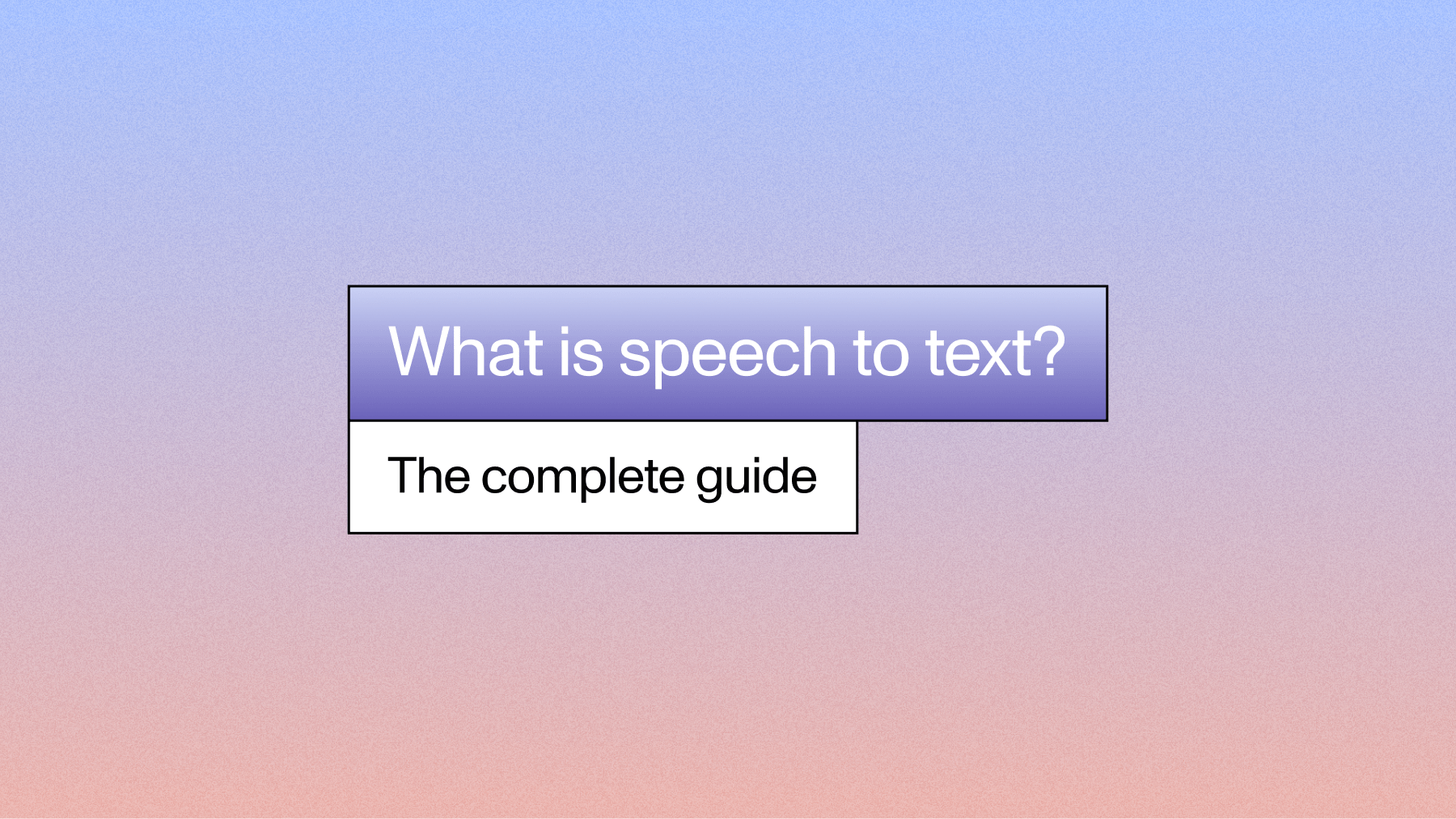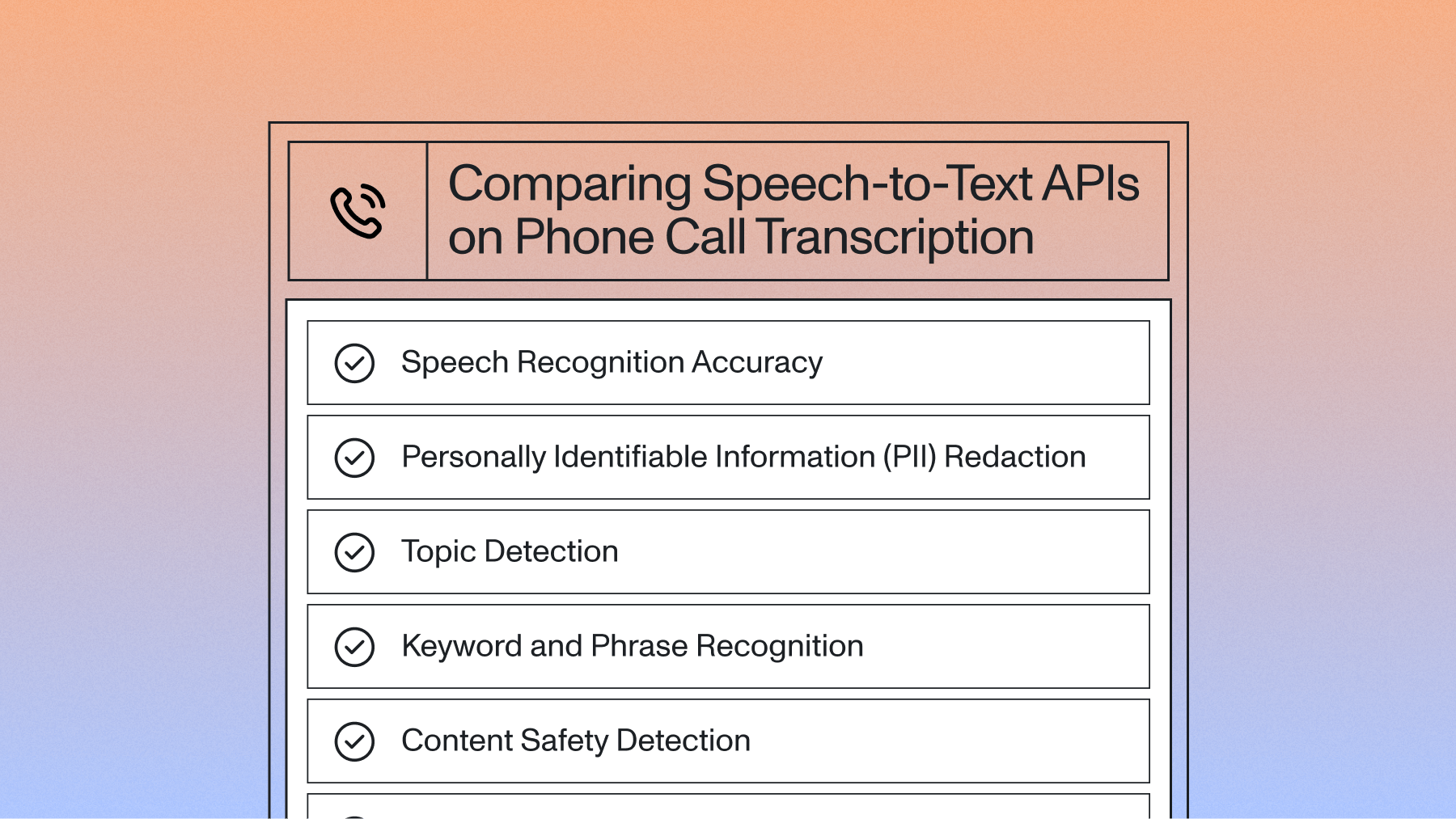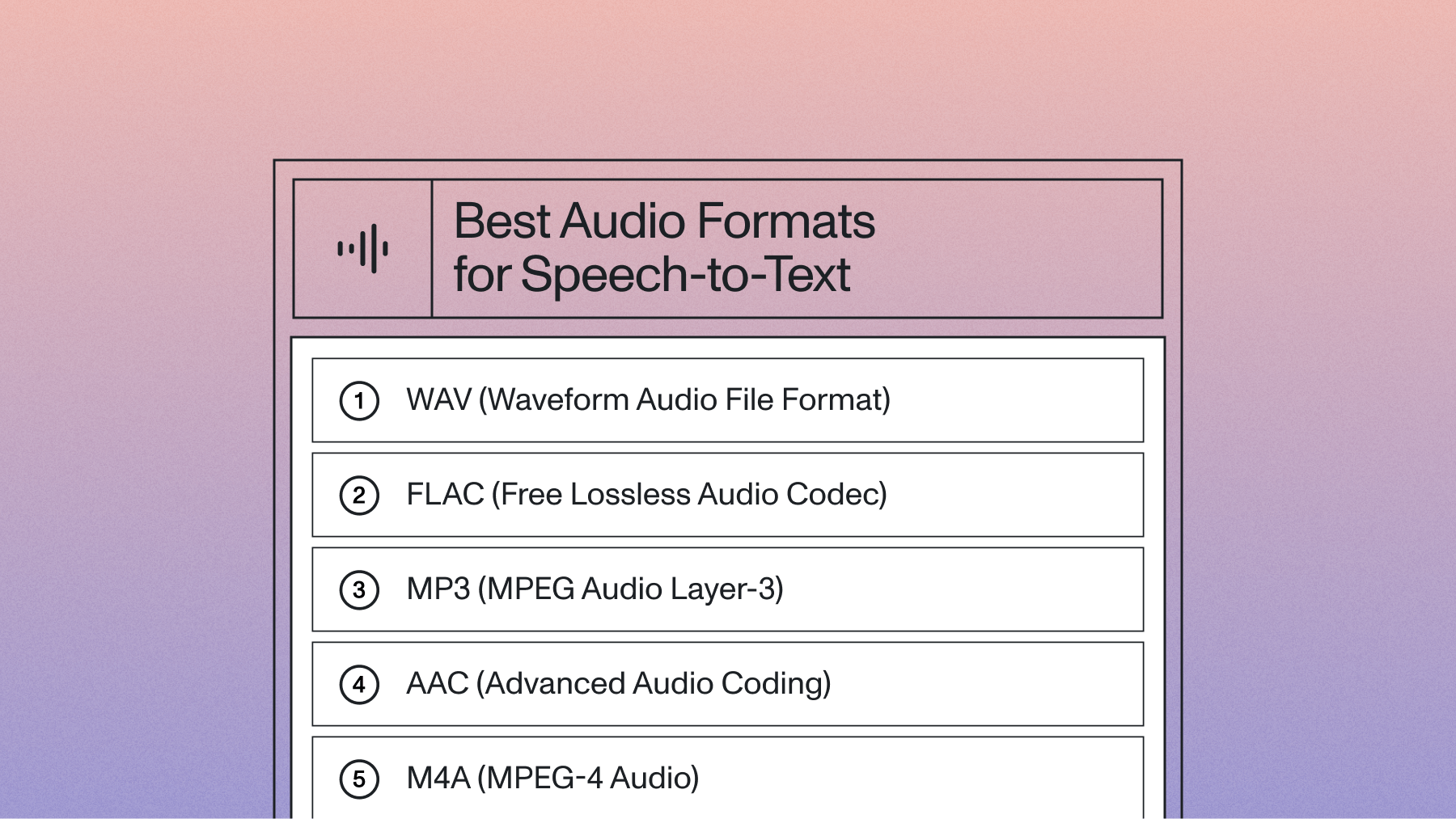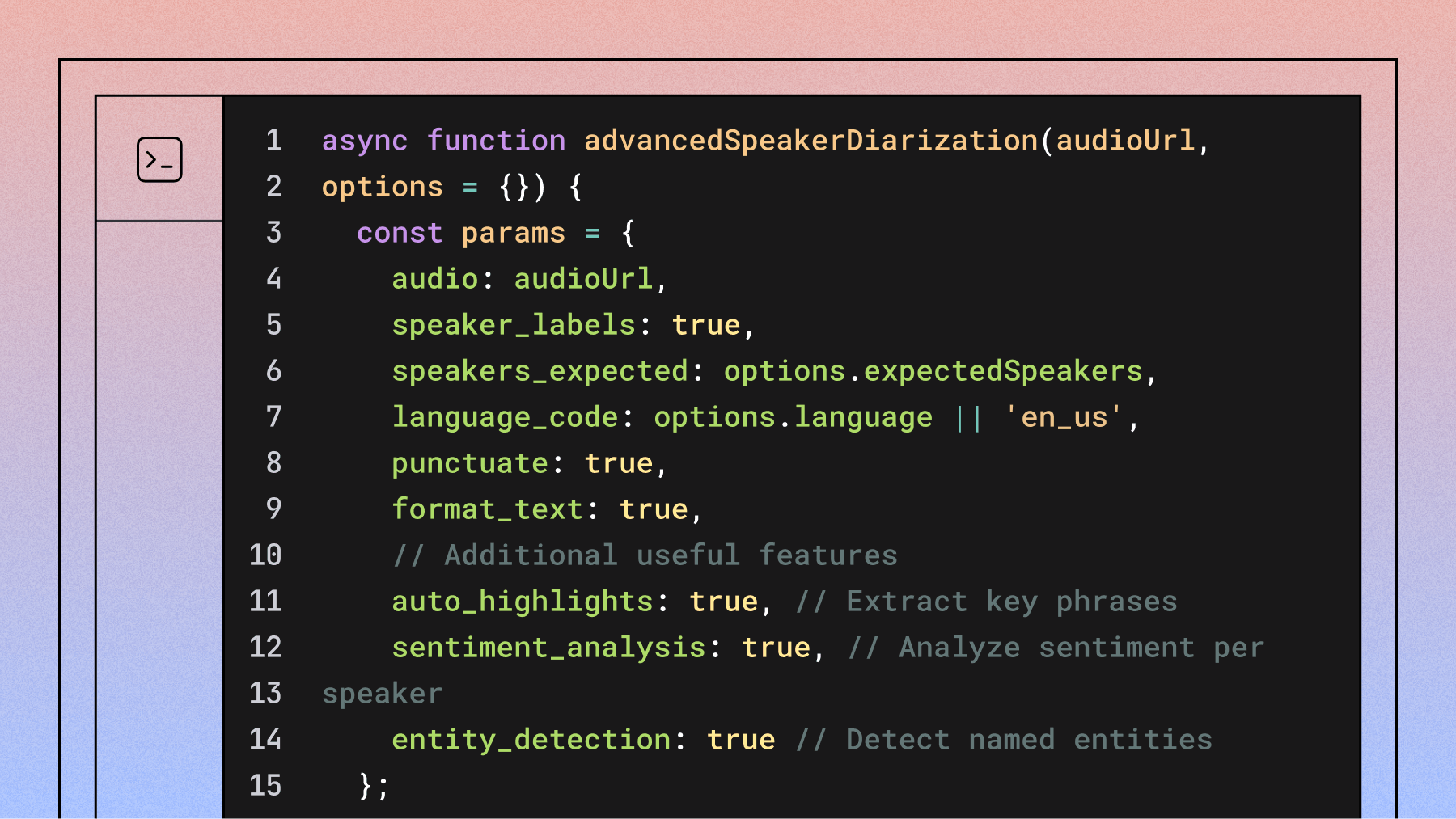Speech-to-text (also known as speech recognition or voice recognition) is a technology that converts spoken language into written text. It's the digital ears that listen and the virtual hands that type to translate our voices into words on a screen. This seemingly simple concept is transforming entire industries, and industry forecasts project that the use of speech recognition technology will grow over 14% year-over-year for the foreseeable future.
Imagine:
- Drafting emails while stuck in traffic
- Transcribing meetings without furiously scribbling notes
- Providing real-time captions for videos and real-time events
These are just a few examples of how speech-to-text is changing life and work for individuals and businesses.
Whether you're a curious individual looking to boost productivity or a business leader seeking to innovate, speech-to-text can change the way you get things done in today's voice-first world.
This complete guide to speech-to-text will walk you through everything you need to know about this technology, including: what it is, how it works, and why we need it.
What is speech-to-text technology?
Speech-to-text technology converts spoken words into written text using artificial intelligence. It enables machines to understand and transcribe human speech across various applications and industries.
This technology combines linguistics, computer science, and AI to function effectively. Here's how modern speech-to-text models work:
- Audio Input: The system receives an audio signal, typically from a microphone or an audio file.
- Signal Processing: The audio is preprocessed for transcoding and audio gain normalization.
- Deep Learning Speech Recognition Model: The audio signal is fed into a speech recognition deep learning model trained on a large corpus of audio-transcription pairs, which generates the transcription of the input audio.
- Text formatting: The raw transcription generated by the speech recognition model is formatted for better readability. This includes adding punctuation, converting phrases like "one hundred dollars" to "$100," capitalizing proper nouns, and other enhancements.
Modern speech-to-text systems often use machine learning algorithms (particularly deep learning neural networks) to improve their accuracy and adapt to different accents, languages, and speech patterns.
Types of speech-to-text engines
There are several types of speech-to-text engines to consider, each with its own advantages, disadvantages, and ideal use cases.
The right choice for you will depend on your needs for accuracy requirements, language support, integration capabilities, and data privacy concerns.
Cloud-based vs. on-premise
- Cloud-based: These systems process audio on remote servers, offering scalability and no infrastructure maintenance. They're ideal for businesses handling large volumes of data or requiring real-time transcription.
- On-premise: These systems run locally on the user's hardware and can function without internet connectivity. The cost is sometimes less than cloud-based, however, initial costs for hardware and ongoing costs of maintenance and support staff can negate these savings.
Test cloud speech-to-text accuracy instantly
Try AssemblyAI's interactive Playground in your browser. Upload audio and see punctuation, casing, and readable formatting applied automatically.
Open playground
Open-source vs. proprietary
- Open-source: These engines allow users to view and sometimes modify and distribute the source code, though with specified limitations. They offer flexibility and customization options but may require more technical expertise to implement and maintain.
- Proprietary: Developed and maintained by specific companies, these systems can be tailor-made for specific use-cases, such as industry-relevant audio as we do. Look for proprietary engines that are also continuously updated.
Learn more about cloud-based security measures
How speech-to-text evolved
Speech-to-text isn't new, but its capabilities have grown exponentially. The journey began in the 1950s, with early research from Bell Labs producing “Audrey,” a system that could only recognize a handful of digits spoken by a single person.
For decades, progress was slow, limited by computing power and data availability. The first major leap came with Hidden Markov Models (HMMs), which allowed systems to predict the probability of word sequences.
The real revolution started with deep learning and neural networks. By training AI models on massive datasets of audio, modern systems can now learn complex patterns of human speech with remarkable accuracy. This shift moved the technology from a niche tool to a foundational component of modern applications.
How does speech-to-text work?
Understanding how speech-to-text works reveals why accuracy depends on several factors:
- Audio quality: Clear input produces better results
- Speaker variation: Accents and dialects affect recognition
- Environmental factors: Background noise impacts performance
1. Audio preprocessing
Before any analysis can begin, the audio input needs to be converted into a format usable by a speech recognition deep learning model. This involves:
- Transcoding: Change the audio format to a standard form (See best audio file formats for speech-to-text).
- Normalization: Adjusting the volume to a standard level.
- Segmentation: Breaking the audio into manageable chunks.
2. Deep Learning speech recognition model
This process maps the audio signal to a sequence of words. Modern systems use end-to-end deep learning models, often based on architectures like the Transformer and Conformer. While these architectures are foundational, AssemblyAI's production models, like Universal, are highly optimized systems trained on massive datasets to deliver state-of-the-art accuracy.
The model is trained on large datasets of audio-text pairs to learn the mapping from audio signals to transcriptions. It implicitly acquires knowledge of how each word should sound and how different words connect to form sentences.
To be more precise, the model generates the likelihood of each word being spoken for each short time frame. A decoder then generates the most probable word sequence based on these likelihood values.
3. Text formatting
The word sequence generated by the deep learning model often lacks punctuation and capitalization. Entities like emails, URLs, and numbers are typically spelled out.
The final step converts this raw sequence into readable text through inverse text normalization, capitalization, and true-casing. These processes use rule-based algorithms or text processing neural network models.
Factors affecting speech-to-text accuracy
While that might sound relatively straightforward, there are a few factors that can muddy up audio files and impact the accuracy of speech-to-text systems:
- Audio quality: Clear, high-quality audio with minimal background noise yields the best results. Poor microphone quality or low bitrate audio can significantly reduce accuracy.
- Accents and dialects: Systems trained on a specific set of accents may struggle with others.
- Background noise and reverberation: Ambient sounds and room reverberation can interfere with speech recognition. Noise cancellation using microphone arrays often results in improved speech recognition accuracy, whereas the usefulness of monaural noise reduction systems is not well established.
- Speaking style: Clear, well-enunciated speech is easier to recognize. Rapid speech, mumbling, or overlapping voices can challenge the system.
- Vocabulary: Uncommon words, technical jargon, or proper nouns may be misrecognized. Some systems allow for custom vocabulary to improve accuracy in specific domains.
- Language and context: Multi-language environments can be challenging. Understanding context helps in disambiguating similar-sounding words.
- Speaker variability: Differences in pitch, speed, and vocal characteristics can affect accuracy. Some systems can adapt to individual speakers over time.
See how audio quality impacts accuracy
Upload clean and noisy files in the AssemblyAI Playground to compare results. Explore punctuation, casing, and timestamps across accents and environments.
Try playground
Benefits of speech-to-text technology
Speech-to-text technology provides major advantages for both individuals and businesses across various industries. And, it's still in its relative infancy — we're sure to see even more innovative applications and benefits as users continue to adopt and innovate with speech-to-text.
- Increased productivity: Speech-to-text can reduce time spent on manual transcription and note-taking.
- Improved accessibility: This technology provides support for individuals with hearing impairments, mobility issues, or learning disabilities, building on a history of federal accessibility requirements like the mandate for captioning capabilities in television sets made after 1993.
- Better customer experiences: Businesses using speech-to-text in customer service operations can reduce average handling time and improve first-call resolution rates.
- Cost reduction: Automated transcription can be cheaper than human transcription services and allows businesses to reallocate resources to more complex, high-value tasks.
- Better data analysis: Speech-to-text enables more efficient analysis of large volumes of data (leading to more informed decision-making).
- Improved compliance and record-keeping: Speech-to-text provides accurate documentation of conversations and meetings.
- Flexibility and convenience: This technology can be used across various devices and integrated with existing software to offer users flexibility in how and where they work.
Applications of speech-to-text technology
Speech-to-text technology has found its way into several applications across various industries and personal use cases. You might have even already used it today without even thinking about it (like with Siri or Alexa).
Here are a few of the most prominent applications and real-world examples for personal and business use:
Personal use cases
- Dictation and note-taking: Students and professionals use speech-to-text to quickly capture ideas, create documents, or take notes during lectures and meetings. For example, a journalist might use speech-to-text to transcribe interviews in real time, saving hours of manual transcription work.
- Accessibility: Speech-to-text provides support for individuals with hearing impairments. It enables real-time captioning of live events, phone calls, and video content to make information more accessible.
- Voice commands and virtual assistants: Speech-to-text powers virtual assistants like Siri, Alexa, and Google Assistant, and market analysis shows these common assistants collectively hold an estimated 92.4% of the U.S. market share, allowing users to set reminders, send messages, or control smart home devices using their voice.
Business applications
- Customer service and call centers: Many companies use speech-to-text to transcribe customer calls automatically. This allows for easier analysis of customer interactions, identification of common issues, and improvement of service quality.
- Meeting transcription: Businesses use speech-to-text to create searchable archives of meetings and conferences. This helps with record-keeping, allows absent team members to catch up, and makes it easier to reference important discussions later.
- Content creation: Podcasters and video creators use speech-to-text to generate accurate transcripts and subtitles for their content to improve accessibility and SEO.
- Legal and medical transcription: Law firms and healthcare providers use specialized speech-to-text systems to transcribe depositions, court proceedings, and medical notes.
Scale speech-to-text for your business
Talk with our team about compliance, security, and deployment options. Get guidance on real-time, batch, and multilingual use cases.
Talk to AI expert
Real-world examples of speech-to-text technology
Jiminny, a Conversation Intelligence platform, uses AssemblyAI's speech-to-text technology to power its sales coaching and call recording features. This integration helps Jiminny's customers secure a 15% higher win rate on average by providing AI insights for data-driven coaching that improves forecasting accuracy and customer knowledge.
Marvin, a qualitative data analysis platform, integrated AssemblyAI's speech transcription and PII redaction models into their user research tools. This implementation helps Marvin's users spend 60% less time on average analyzing data, allowing them to focus more on extracting meaningful insights from customer interviews and feedback.
Screenloop, a hiring intelligence platform, embedded AssemblyAI's transcription model into their interview process tools. This integration resulted in significant improvements for Screenloop's customers, including 90% less time spent on manual hiring tasks, 20% reduced time-to-hire, 60% less candidate drop-off, and 50% fewer rejected offers for open roles.
Free vs. paid speech-to-text solutions
When exploring speech-to-text, you'll find both free and paid options, and the right choice depends entirely on your goal.
| Solution Type |
Best For |
Limitations |
| Free Tools |
Simple, one-off tasks |
Usage limits, lower accuracy, maintenance burden |
| Paid APIs |
Production applications |
Cost per usage, requires integration |
Free tools work well for transcribing short audio clips. However, they often come with trade-offs in accuracy and reliability.
For developers or businesses, these limitations can quickly become a significant resource drain.
Paid solutions, typically offered as an API, are designed for building reliable, scalable products. Companies like AssemblyAI handle the immense complexity of training, maintaining, and improving the underlying AI models. This allows you to focus on your product's core features while benefiting from high accuracy, robust security, dedicated support, and advanced capabilities like speaker diarization and content summarization.
How to choose the right speech-to-text tool
Not every speech-to-text solution is going to be the right fit for your business and its use case.
Here are few factors to consider to narrow down the best tool for your needs:
- Accuracy: Look for tools with high transcription accuracy rates. In fact, a recent survey of over 200 tech leaders found that accuracy, quality, and performance were among the top three most important factors when evaluating an AI vendor. State-of-the-art models like AssemblyAI's Universal and Slam-1 models achieve near-human-level performance across a wide range of data.
- Language support: Consider whether the tool supports the languages you need. Some solutions offer multilingual capabilities, while others specialize in specific languages or dialects.
- Pricing: Compare pricing models (pay-as-you-go, subscription-based, etc.) and guarantee they align with your usage patterns and budget.
- Integration options: Check if the tool easily integrates with your existing systems and workflows. APIs and SDKs can facilitate seamless integration.
- Customization capabilities: Look for features like custom vocabulary or acoustic model adaptation that can improve accuracy for your specific use case.
- Processing speed: Consider both real-time transcription capabilities and batch processing speeds for pre-recorded audio.
- Additional features: Evaluate extra functionalities like speaker diarization, punctuation, sentiment analysis, or content summarization.
- Security and compliance: Double-check that the tool meets your data security requirements and complies with relevant regulations (like GDPR and HIPAA), as an industry survey revealed that over 30% of product leaders see security as a significant challenge for integration.
- Scalability: Choose a solution that can handle your current needs and scale as your requirements grow.
- Support and documentation: Consider the level of technical support and the quality of documentation provided by the vendor.
Popular speech-to-text tools
1. AssemblyAI
AssemblyAI is a powerful, developer-friendly speech-to-text API that leverages cutting-edge AI models to provide accurate transcription and advanced audio intelligence features. It offers both streaming (real-time) and asynchronous transcription capabilities — making it reliable for a wide range of applications from live captioning to post-production content analysis.
Features:
- State-of-the-art accuracy with our Universal and Slam-1 models
- Streaming (real-time) and asynchronous transcription
- Custom vocabulary
- Speech Understanding: Speaker diarization, sentiment analysis, content summarization, topic detection, and more
- Multilingual support
Pros:
- Highly accurate transcriptions
- Comprehensive API with advanced AI features
- Excellent documentation and customer support
- Flexible pricing for various usage levels
Cons:
- Primarily focused on API integration — may not be ideal for non-technical users
Pricing:
- Free tier: $50 in free credits
- Pay-as-you-go: Starting from $0.15/hr
- Custom: Personalize your plan
2. Google Cloud Speech-to-Text
Google Cloud Speech-to-Text is a cloud-based speech recognition service that converts audio to text using Google's machine learning technology. It offers a wide range of language support and integrates seamlessly with other Google Cloud services, making it a versatile choice for businesses already using the Google ecosystem.
Features:
- Real-time and asynchronous transcription
- Support for 125+ languages and variants
- Noise cancellation and speaker diarization
- Integration with other Google Cloud services
Pros:
- Wide language support
- Good integration with Google ecosystem
- Reliable and scalable
Cons:
- Can be complex for beginners
- Less competitive pricing for high-volume users
- Lower accuracy
Pricing:
- Free tier: First 60 minutes per month
- Standard recognition: $0.016 per minute for the first 500,000 minutes/month, with tiered pricing for higher volumes
- Medical models: $0.078 per minute after the free 60 minutes/month
- Dynamic batch recognition: $0.003 per minute
- Discounted rates available for data logging options
3. Amazon Transcribe
Amazon Transcribe is a cloud-based automatic speech recognition (ASR) service that makes it easy for developers to add speech-to-text capability to their applications. As part of the AWS ecosystem, it offers seamless integration with other Amazon services and provides both real-time and batch transcription options.
Features:
- Real-time and batch transcription
- Custom vocabulary and language models
- Automatic language identification
- Speaker diarization and channel separation
- Integration with AWS ecosystem
Pros:
- Seamless integration with AWS services
- Good accuracy for common use cases
- Scalable for large-volume transcription needs
Cons:
- Learning curve for AWS environment
- Limited advanced AI features compared to specialized providers
- High cost
- Limited accuracy for more specialized use cases
Pricing:
- Free tier: 60 minutes of transcription per month for the first 12 months
- Standard transcription: $0.00043 per second ($0.0258 per minute)
- Real-time transcription: $0.00067 per second ($0.0402 per minute)
Getting started with speech-to-text
Integrating speech-to-text is more accessible than you might think. Here's a simple path to get started:
- Define your goal. What do you want to achieve? Are you transcribing meetings for searchable records, analyzing customer calls for sentiment, or adding captions to video content? A clear goal will guide your technical choices.
- Choose your approach. For personal use, a simple transcription app might be enough. If you're building a product, a speech-to-text API is the way to go. An API allows you to integrate transcription directly into your application's workflow.
- Start building (for developers). Find a developer-friendly API, sign up for a free API key, and read the documentation. Most providers offer quickstart guides that let you make your first transcription request in just a few minutes with a few lines of code.
Common challenges and limitations
While modern speech-to-text is incredibly powerful, it's not perfect. Key limitations include:
Accuracy limitations
Even the best models struggle with specialized jargon or unique proper nouns
Environmental challenges
Background noise and poor audio quality significantly impact performance
Contextual understanding
AI models don't truly understand context like humans do, which can lead to significant errors. For example, one systematic review in a clinical setting found that speech recognition resulted in a higher number of errors and was 18% slower for documentation compared to manual keyboarding.
Understanding these limitations helps you set realistic expectations and design better products.
- The final mile of accuracy. Even the best models can struggle with highly specialized jargon, strong accents, or unique proper nouns without customization.
- Noisy environments. Background noise, multiple people speaking at once, and poor microphone quality are the biggest enemies of accuracy, as research shows word error rates can jump from near-zero in controlled settings to over 50% in multi-speaker scenarios. Clean audio is critical for clean text.
- Contextual understanding. AI models don't truly 'understand' context like humans do. This can lead to errors with homophones (like 'to,' 'too,' and 'two') or ambiguous phrases.
- Bias and fairness. AI models are trained on data, and if that data is not diverse, the model may perform less accurately for certain demographic groups. For instance, a notable study found a 16 percentage-point gap in transcription accuracy between Black and white participants' voices. Responsible providers actively work to mitigate this bias.
The future of speech-to-text technology
Speech-to-text technology is poised for exciting advancements, especially with current AI research breakthroughs.
Expected improvements include:
- Enhanced accuracy: Better performance in noisy environments with multiple speakers
- Advanced features: Emotion detection and intent recognition capabilities
- Context understanding: More sophisticated meaning extraction beyond basic transcription
New applications will emerge across industries. In healthcare, more accurate medical transcription could improve patient care and streamline documentation. Education might see personalized learning experiences based on real-time speech analysis.
However, challenges remain. Privacy concerns and data security will be ongoing issues as these systems process increasingly sensitive information. There's also the risk of bias in AI models, which could lead to unequal performance across different demographics or accents.
Unlock the power of speech-to-text with AssemblyAI
Speech-to-text technology has revolutionized how we interact with devices, create content, and process information. However, you're not just a user of this technology — you can be a builder.
AssemblyAI provides a powerful, developer-friendly speech-to-text API that leverages cutting-edge AI models. It provides both streaming (real-time) and asynchronous transcription capabilities for a variety of applications. You also get access to features like:
- Custom vocabulary for improved accuracy in specific domains
- Advanced AI models like speaker diarization, sentiment analysis, and content summarization
- Multilingual support for global applications
- Excellent documentation and customer support for smooth integration
Try AssemblyAI today to experience the future of speech recognition technology
Frequently asked questions about speech-to-text
What's the difference between speech-to-text and voice recognition?
The terms are often used interchangeably. Speech-to-text specifically refers to converting spoken words into written text. Voice recognition is a broader term that can also include identifying a specific person's voice (speaker recognition) or understanding commands (voice control).
How accurate is speech-to-text technology?
Leading commercial APIs achieve near-human accuracy on clean audio, but performance decreases with background noise, multiple speakers, or uncommon terminology.
Do I need an internet connection for speech-to-text?
Most high-accuracy systems require internet connectivity for cloud processing, while on-device models work offline but with reduced accuracy.
Can speech-to-text handle multiple speakers?
Yes. This capability is called speaker diarization or speaker labels. Advanced speech-to-text systems can identify and label who is speaking and when, creating a transcript that looks like a script from a conversation.
What's the best free speech-to-text tool for beginners?
For simple tasks, use free web-based tools; for development, choose API providers with generous free tiers to test production-grade accuracy.
Title goes here
Lorem ipsum dolor sit amet, consectetur adipiscing elit, sed do eiusmod tempor incididunt ut labore et dolore magna aliqua. Ut enim ad minim veniam, quis nostrud exercitation ullamco laboris nisi ut aliquip ex ea commodo consequat. Duis aute irure dolor in reprehenderit in voluptate velit esse cillum dolore eu fugiat nulla pariatur.










